- GCN/BACODINE POSITION NOTICE
TITLE: GCN/SWIFT NOTICE
NOTICE_DATE: Wed 01 Sep 10 13:35:06 UT
NOTICE_TYPE: Swift-BAT GRB Position
TRIGGER_NUM: 433065, Seg_Num: 0
GRB_RA: 27.245d {+01h 48m 59s} (J2000),
27.393d {+01h 49m 34s} (current),
26.552d {+01h 46m 12s} (1950)
GRB_DEC: +22.744d {+22d 44' 39"} (J2000),
+22.797d {+22d 47' 49"} (current),
+22.496d {+22d 29' 46"} (1950)
GRB_ERROR: 3.00 [arcmin radius, statistical only]
GRB_INTEN: 30937 [cnts] Image_Peak=450 [image_cnts]
TRIGGER_DUR: 8.192 [sec]
TRIGGER_INDEX: 477 E_range: 25-100 keV
BKG_INTEN: 223345 [cnts]
BKG_TIME: 48761.86 SOD {13:32:41.86} UT
BKG_DUR: 64 [sec]
GRB_DATE: 15440 TJD; 244 DOY; 10/09/01
GRB_TIME: 48850.37 SOD {13:34:10.37} UT
GRB_PHI: 165.73 [deg]
GRB_THETA: 41.04 [deg]
SOLN_STATUS: 0x3
RATE_SIGNIF: 10.19 [sigma]
IMAGE_SIGNIF: 7.70 [sigma]
MERIT_PARAMS: +1 +0 +0 +3 +2 -2 +0 +0 +57 +0
SUN_POSTN: 160.61d {+10h 42m 26s} +8.19d {+08d 11' 27"}
SUN_DIST: 124.72 [deg] Sun_angle= 8.9 [hr] (West of Sun)
MOON_POSTN: 64.70d {+04h 18m 48s} +24.15d {+24d 09' 02"}
MOON_DIST: 34.15 [deg]
MOON_ILLUM: 52 [%]
GAL_COORDS: 139.89,-38.23 [deg] galactic lon,lat of the burst (or transient)
ECL_COORDS: 33.42, 10.76 [deg] ecliptic lon,lat of the burst (or transient)
COMMENTS: SWIFT-BAT GRB Coordinates.
COMMENTS: This is a rate trigger.
COMMENTS: A point_source was found.
COMMENTS: This does not match any source in the on-board catalog.
COMMENTS: This does not match any source in the ground catalog.
COMMENTS: This is a GRB.
COMMENTS: This trigger occurred at longitude,latitude = 258.30,12.07 [deg].
- red DSS finding chart
ps-file
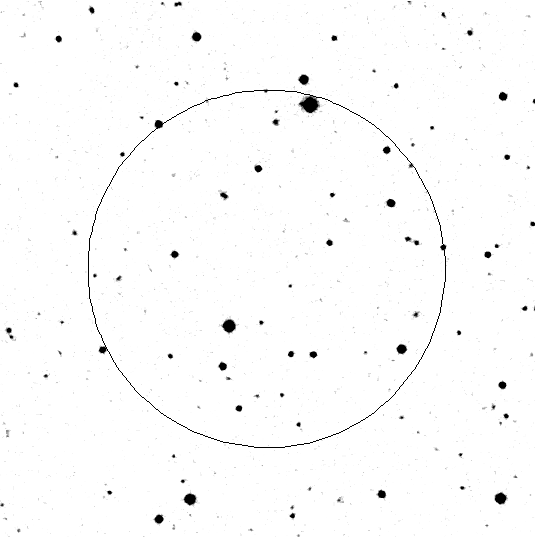
- GCN NOTICE
TITLE: GCN/SWIFT NOTICE
NOTICE_DATE: Wed 01 Sep 10 13:40:08 UT
NOTICE_TYPE: Swift-BAT GRB Lightcurve
TRIGGER_NUM: 9085451, Seg_Num: 6
GRB_RA: 27.245d {+01h 48m 59s} (J2000),
27.393d {+01h 49m 34s} (current),
26.552d {+01h 46m 12s} (1950)
GRB_DEC: +22.744d {+22d 44' 39"} (J2000),
+22.797d {+22d 47' 49"} (current),
+22.496d {+22d 29' 46"} (1950)
GRB_DATE: 15440 TJD; 244 DOY; 10/09/01
GRB_TIME: 48850.37 SOD {13:34:10.37} UT
TRIGGER_INDEX: 477
GRB_PHI: 165.73 [deg]
GRB_THETA: 41.04 [deg]
DELTA_TIME: -5810.00 [sec]
TRIGGER_DUR: 8.192 [sec]
SOLN_STATUS: 0x3
RATE_SIGNIF: 0.00 [sigma]
IMAGE_SIGNIF: 0.00 [sigma]
LC_URL: sw00433065000msb.lc
SUN_POSTN: 160.61d {+10h 42m 26s} +8.19d {+08d 11' 23"}
SUN_DIST: 124.73 [deg] Sun_angle= 8.9 [hr] (West of Sun)
MOON_POSTN: 64.75d {+04h 19m 00s} +24.15d {+24d 09' 17"}
MOON_DIST: 34.19 [deg]
MOON_ILLUM: 52 [%]
GAL_COORDS: 139.89,-38.23 [deg] galactic lon,lat of the burst (or transient)
ECL_COORDS: 33.42, 10.76 [deg] ecliptic lon,lat of the burst (or transient)
COMMENTS: SWIFT-BAT GRB Lightcurve.
COMMENTS:
COMMENTS: WARNING: No BAT_Position TDRSS message was received for this trigger_number!
COMMENTS:
COMMENTS:
COMMENTS: The next comments were copied from the BAT_POS Notice:
COMMENTS: This is a rate trigger.
COMMENTS: A point_source was found.
COMMENTS: This does not match any source in the on-board catalog.
COMMENTS: This does not match any source in the ground catalog.
COMMENTS: This is a GRB.
COMMENTS: This trigger occurred at longitude,latitude = 258.30,12.07 [deg].
COMMENTS: The 3rd packet (of 3) was missing in the lightcurve data stream.
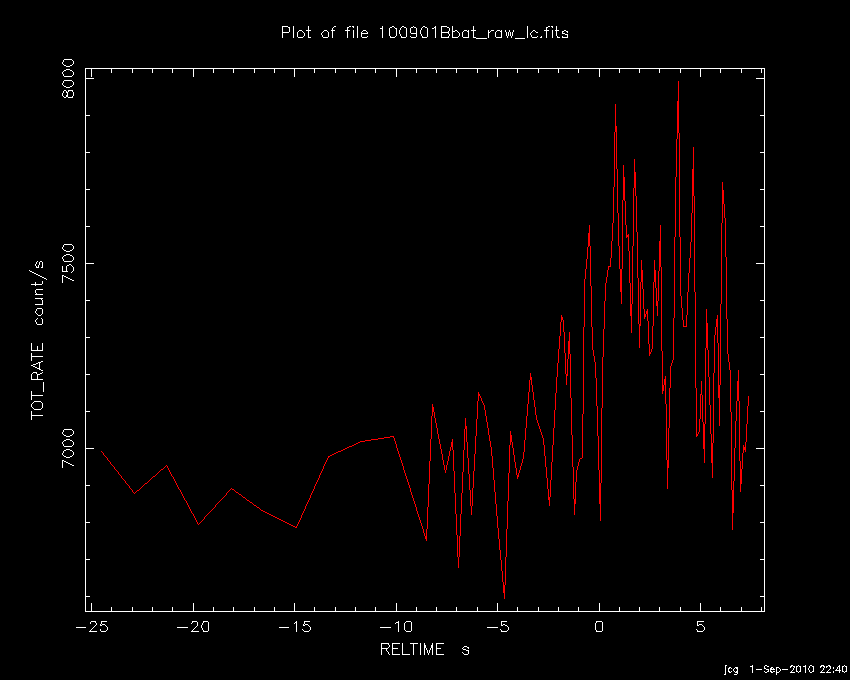
- GCN NOTICE
TITLE: GCN/SWIFT NOTICE
NOTICE_DATE: Wed 01 Sep 10 13:50:34 UT
NOTICE_TYPE: Swift-UVOT Source List
TRIGGER_NUM: 433065, Seg_Num: 0
POINT_RA: 27.284d {+01h 49m 08s} (J2000)
POINT_DEC: +22.704d {+22d 42' 16"} (J2000)
POINT_ROLL: 61.213d
IMG_START_DATE: 15440 TJD; 244 DOY; 10/09/01
IMG_START_TIME: 48997.64 SOD {13:36:37.64} UT, 147.3 [sec] since BAT Trigger Time
FILTER: 10, White
BKG_MEAN: 4.507
N_STARS: 15
X_OFFSET: 225 [pixels]
Y_OFFSET: 251 [pixels]
X_MAX: 1184 [pixels]
Y_MAX: 1210 [pixels]
DET_THRESH: 18
PHOTO_THRESH: 10
SL_URL: sw00433065000msufc0147.fits
SUN_POSTN: 160.62d {+10h 42m 28s} +8.19d {+08d 11' 13"}
SUN_DIST: 124.72 [deg] Sun_angle= 8.9 [hr] (West of Sun)
MOON_POSTN: 64.85d {+04h 19m 25s} +24.16d {+24d 09' 48"}
MOON_DIST: 34.26 [deg]
MOON_ILLUM: 52 [%]
GAL_COORDS: 139.95,-38.25 [deg] galactic lon,lat of the pointing direction
ECL_COORDS: 33.44, 10.71 [deg] ecliptic lon,lat of the pointing direction
COMMENTS: SWIFT-UVOT Source List.
- GCN NOTICE
TITLE: GCN/SWIFT NOTICE
NOTICE_DATE: Wed 01 Sep 10 13:50:34 UT
NOTICE_TYPE: Swift-UVOT Source List
TRIGGER_NUM: 433065, Seg_Num: 0
POINT_RA: 27.284d {+01h 49m 08s} (J2000)
POINT_DEC: +22.704d {+22d 42' 16"} (J2000)
POINT_ROLL: 61.213d
IMG_START_DATE: 15440 TJD; 244 DOY; 10/09/01
IMG_START_TIME: 48997.64 SOD {13:36:37.64} UT, 147.3 [sec] since BAT Trigger Time
FILTER: 10, White
BKG_MEAN: 4.507
N_STARS: 15
X_OFFSET: 225 [pixels]
Y_OFFSET: 251 [pixels]
X_MAX: 1184 [pixels]
Y_MAX: 1210 [pixels]
DET_THRESH: 18
PHOTO_THRESH: 10
SL_URL: sw00433065000msufc0147.fits
SUN_POSTN: 160.62d {+10h 42m 28s} +8.19d {+08d 11' 13"}
SUN_DIST: 124.72 [deg] Sun_angle= 8.9 [hr] (West of Sun)
MOON_POSTN: 64.85d {+04h 19m 25s} +24.16d {+24d 09' 48"}
MOON_DIST: 34.26 [deg]
MOON_ILLUM: 52 [%]
GAL_COORDS: 139.95,-38.25 [deg] galactic lon,lat of the pointing direction
ECL_COORDS: 33.44, 10.71 [deg] ecliptic lon,lat of the pointing direction
COMMENTS: SWIFT-UVOT Source List.
- GCN NOTICE
TITLE: GCN/SWIFT NOTICE
NOTICE_DATE: Wed 01 Sep 10 13:50:57 UT
NOTICE_TYPE: Swift-UVOT Processed Source List
TRIGGER_NUM: 433065, Seg_Num: 0
POINT_RA: 27.284d {+01h 49m 08s} (J2000)
POINT_DEC: +22.704d {+22d 42' 16"} (J2000)
POINT_ROLL: 61.213d
IMG_START_DATE: 15440 TJD; 244 DOY; 10/09/01
IMG_START_TIME: 48997.64 SOD {13:36:37.64} UT, 147.3 [sec] since BAT Trigger Time
FILTER: 10, White
BKG_MEAN: 4.507
N_STARS: 15
X_OFFSET: 225 [pixels]
Y_OFFSET: 251 [pixels]
X_MAX: 1184 [pixels]
Y_MAX: 1210 [pixels]
DET_THRESH: 18
PHOTO_THRESH: 10
SL_URL: sw00433065000msufc0147.fits
SUN_POSTN: 160.62d {+10h 42m 28s} +8.19d {+08d 11' 13"}
SUN_DIST: 124.72 [deg] Sun_angle= 8.9 [hr] (West of Sun)
MOON_POSTN: 64.86d {+04h 19m 26s} +24.16d {+24d 09' 49"}
MOON_DIST: 34.26 [deg]
MOON_ILLUM: 52 [%]
GAL_COORDS: 139.95,-38.25 [deg] galactic lon,lat of the pointing direction
ECL_COORDS: 33.44, 10.71 [deg] ecliptic lon,lat of the pointing direction
COMMENTS: SWIFT-UVOT Processed Source List.
COMMENTS: All 4 attachments are included.
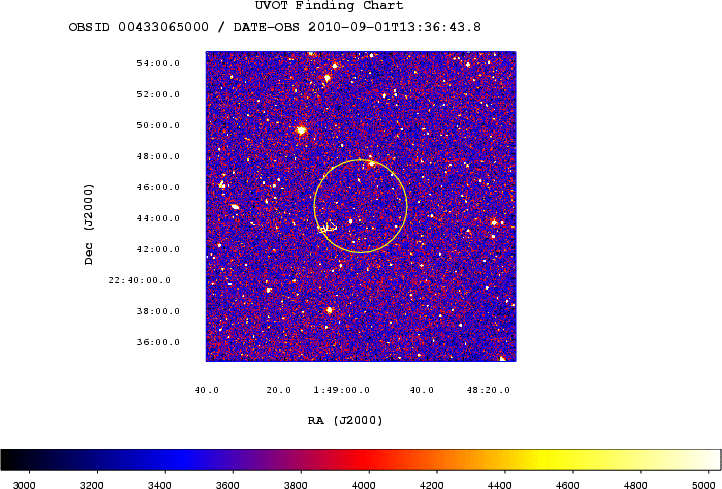
- GCN NOTICE
TITLE: GCN/SWIFT NOTICE
NOTICE_DATE: Wed 01 Sep 10 13:51:58 UT
NOTICE_TYPE: Swift-UVOT Image
TRIGGER_NUM: 433065, Seg_Num: 0
POINT_RA: 27.284d {+01h 49m 08s} (J2000)
POINT_DEC: +22.704d {+22d 42' 16"} (J2000)
ROLL: 61.213d
IMG_START_DATE: 15440 TJD; 244 DOY; 10/09/01
IMG_START_TIME: 48997.64 SOD {13:36:37.64} UT, 147.3 [sec] since BAT Trigger Time
FILTER: 10, White
EXPOSURE_ID: 305041003
X_OFFSET: 544 [pixels]
Y_OFFSET: 570 [pixels]
WIDTH: 160 [pixels]
HEIGHT: 160 [pixels]
X_GRB_POS: 704
Y_GRB_POS: 730
BINNING_INDEX: 1
IM_URL: sw00433065000msuni0154.fits
SUN_POSTN: 160.62d {+10h 42m 28s} +8.19d {+08d 11' 12"}
SUN_DIST: 124.72 [deg] Sun_angle= 8.9 [hr] (West of Sun)
MOON_POSTN: 64.87d {+04h 19m 28s} +24.16d {+24d 09' 52"}
MOON_DIST: 34.27 [deg]
MOON_ILLUM: 52 [%]
GAL_COORDS: 139.95,-38.25 [deg] galactic lon,lat of the pointing direction
ECL_COORDS: 33.44, 10.71 [deg] ecliptic lon,lat of the pointing direction
COMMENTS: SWIFT-UVOT Image.
COMMENTS: The GRB Position came from the Window Position in the Mode Command.
COMMENTS: The image has 2x2 binning (compression).
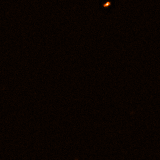
- GCN NOTICE
TITLE: GCN/SWIFT NOTICE
NOTICE_DATE: Wed 01 Sep 10 13:52:13 UT
NOTICE_TYPE: Swift-UVOT Source List
TRIGGER_NUM: 433065, Seg_Num: 0
POINT_RA: 27.282d {+01h 49m 08s} (J2000)
POINT_DEC: +22.702d {+22d 42' 09"} (J2000)
POINT_ROLL: 61.214d
IMG_START_DATE: 15440 TJD; 244 DOY; 10/09/01
IMG_START_TIME: 49155.68 SOD {13:39:15.68} UT, 305.3 [sec] since BAT Trigger Time
FILTER: 7, U
BKG_MEAN: 2.650
N_STARS: 33
X_OFFSET: 0 [pixels]
Y_OFFSET: 11 [pixels]
X_MAX: 1439 [pixels]
Y_MAX: 1450 [pixels]
DET_THRESH: 13
PHOTO_THRESH: 7
SL_URL: sw00433065000msufc0305.fits
SUN_POSTN: 160.62d {+10h 42m 28s} +8.19d {+08d 11' 12"}
SUN_DIST: 124.72 [deg] Sun_angle= 8.9 [hr] (West of Sun)
MOON_POSTN: 64.87d {+04h 19m 29s} +24.16d {+24d 09' 53"}
MOON_DIST: 34.27 [deg]
MOON_ILLUM: 52 [%]
GAL_COORDS: 139.95,-38.26 [deg] galactic lon,lat of the pointing direction
ECL_COORDS: 33.44, 10.71 [deg] ecliptic lon,lat of the pointing direction
COMMENTS: SWIFT-UVOT Source List.
- GCN NOTICE
TITLE: GCN/SWIFT NOTICE
NOTICE_DATE: Wed 01 Sep 10 13:52:33 UT
NOTICE_TYPE: Swift-UVOT Processed Source List
TRIGGER_NUM: 433065, Seg_Num: 0
POINT_RA: 27.282d {+01h 49m 08s} (J2000)
POINT_DEC: +22.702d {+22d 42' 09"} (J2000)
POINT_ROLL: 61.214d
IMG_START_DATE: 15440 TJD; 244 DOY; 10/09/01
IMG_START_TIME: 49155.68 SOD {13:39:15.68} UT, 305.3 [sec] since BAT Trigger Time
FILTER: 7, U
BKG_MEAN: 2.650
N_STARS: 33
X_OFFSET: 0 [pixels]
Y_OFFSET: 11 [pixels]
X_MAX: 1439 [pixels]
Y_MAX: 1450 [pixels]
DET_THRESH: 13
PHOTO_THRESH: 7
SL_URL: sw00433065000msufc0305.fits
SUN_POSTN: 160.62d {+10h 42m 28s} +8.19d {+08d 11' 12"}
SUN_DIST: 124.72 [deg] Sun_angle= 8.9 [hr] (West of Sun)
MOON_POSTN: 64.87d {+04h 19m 29s} +24.16d {+24d 09' 54"}
MOON_DIST: 34.27 [deg]
MOON_ILLUM: 52 [%]
GAL_COORDS: 139.95,-38.26 [deg] galactic lon,lat of the pointing direction
ECL_COORDS: 33.44, 10.71 [deg] ecliptic lon,lat of the pointing direction
COMMENTS: SWIFT-UVOT Processed Source List.
COMMENTS: All 4 attachments are included.
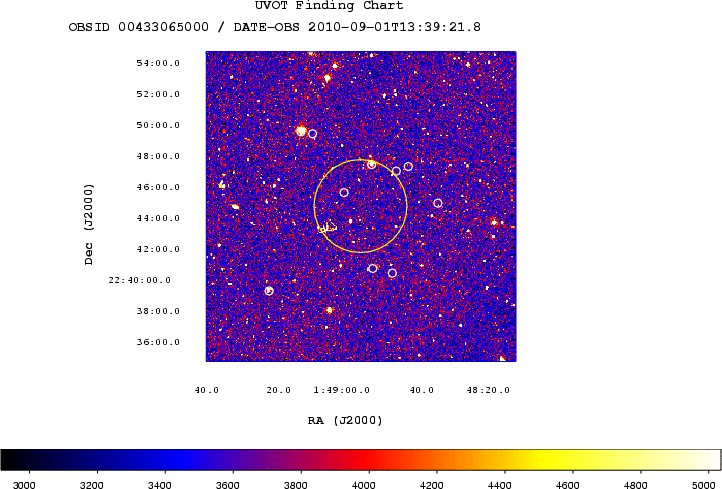
- GCN NOTICE
TITLE: GCN/SWIFT NOTICE
NOTICE_DATE: Wed 01 Sep 10 13:52:13 UT
NOTICE_TYPE: Swift-UVOT Source List
TRIGGER_NUM: 433065, Seg_Num: 0
POINT_RA: 27.282d {+01h 49m 08s} (J2000)
POINT_DEC: +22.702d {+22d 42' 09"} (J2000)
POINT_ROLL: 61.214d
IMG_START_DATE: 15440 TJD; 244 DOY; 10/09/01
IMG_START_TIME: 49155.68 SOD {13:39:15.68} UT, 305.3 [sec] since BAT Trigger Time
FILTER: 7, U
BKG_MEAN: 2.650
N_STARS: 33
X_OFFSET: 0 [pixels]
Y_OFFSET: 11 [pixels]
X_MAX: 1439 [pixels]
Y_MAX: 1450 [pixels]
DET_THRESH: 13
PHOTO_THRESH: 7
SL_URL: sw00433065000msufc0305.fits
SUN_POSTN: 160.62d {+10h 42m 28s} +8.19d {+08d 11' 12"}
SUN_DIST: 124.72 [deg] Sun_angle= 8.9 [hr] (West of Sun)
MOON_POSTN: 64.87d {+04h 19m 29s} +24.16d {+24d 09' 53"}
MOON_DIST: 34.27 [deg]
MOON_ILLUM: 52 [%]
GAL_COORDS: 139.95,-38.26 [deg] galactic lon,lat of the pointing direction
ECL_COORDS: 33.44, 10.71 [deg] ecliptic lon,lat of the pointing direction
COMMENTS: SWIFT-UVOT Source List.
- GCN NOTICE
TITLE: GCN/SWIFT NOTICE
NOTICE_DATE: Wed 01 Sep 10 13:52:28 UT
NOTICE_TYPE: Swift-UVOT Processed Image
TRIGGER_NUM: 433065, Seg_Num: 0
POINT_RA: 27.284d {+01h 49m 08s} (J2000)
POINT_DEC: +22.704d {+22d 42' 16"} (J2000)
ROLL: 61.213d
IMG_START_DATE: 15440 TJD; 244 DOY; 10/09/01
IMG_START_TIME: 48997.64 SOD {13:36:37.64} UT, 147.3 [sec] since BAT Trigger Time
FILTER: 10, White
EXPOSURE_ID: 305041003
X_OFFSET: 544 [pixels]
Y_OFFSET: 570 [pixels]
WIDTH: 160 [pixels]
HEIGHT: 160 [pixels]
X_GRB_POS: 704
Y_GRB_POS: 730
BINNING_INDEX: 1
IM_URL: sw00433065000msuni0154.fits
SUN_POSTN: 160.62d {+10h 42m 28s} +8.19d {+08d 11' 12"}
SUN_DIST: 124.72 [deg] Sun_angle= 8.9 [hr] (West of Sun)
MOON_POSTN: 64.87d {+04h 19m 29s} +24.16d {+24d 09' 54"}
MOON_DIST: 34.27 [deg]
MOON_ILLUM: 52 [%]
GAL_COORDS: 139.95,-38.25 [deg] galactic lon,lat of the pointing direction
ECL_COORDS: 33.44, 10.71 [deg] ecliptic lon,lat of the pointing direction
COMMENTS: SWIFT-UVOT Processed Image.
COMMENTS: The GRB Position came from the Window Position in the Mode Command.
COMMENTS: The image has 2x2 binning (compression).
COMMENTS: All 4 attachments are included.
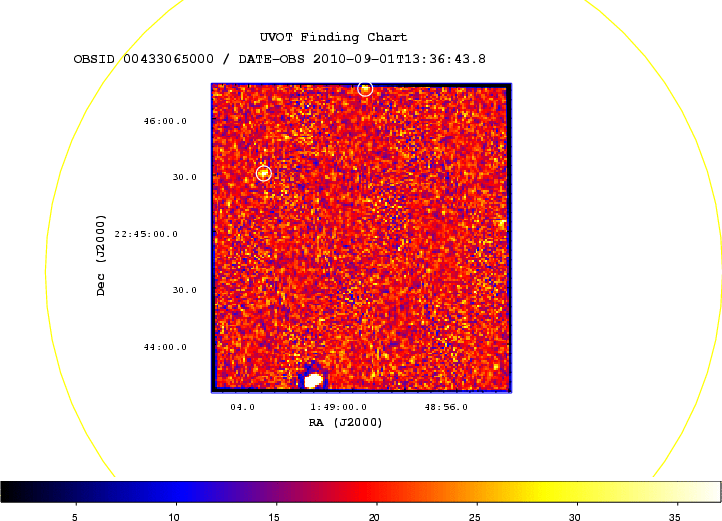
- GCN NOTICE
TITLE: GCN/SWIFT NOTICE
NOTICE_DATE: Wed 01 Sep 10 13:53:55 UT
NOTICE_TYPE: Swift-XRT Position
TRIGGER_NUM: 433065, Seg_Num: 0
GRB_RA: 27.2641d {+01h 49m 03.38s} (J2000),
27.4122d {+01h 49m 38.93s} (current),
26.5710d {+01h 46m 17.04s} (1950)
GRB_DEC: +22.7584d {+22d 45' 30.2"} (J2000),
+22.8112d {+22d 48' 40.1"} (current),
+22.5102d {+22d 30' 36.5"} (1950)
GRB_ERROR: 3.0 [arcsec radius, statistical plus systematic, 90% containment]
GRB_INTEN: 1.00e-10 [erg/cm2/sec]
GRB_SIGNIF: 10.00 [sigma]
IMG_START_DATE: 15440 TJD; 244 DOY; 10/09/01
IMG_START_TIME: 49011.00 SOD {13:36:51.00} UT, 160.6 [sec] since BAT Trigger Time
TAM[0-3]: 100.00 100.00 100.00 100.00
AMPLIFIER: 1
WAVEFORM: 31
SUN_POSTN: 160.62d {+10h 42m 28s} +8.19d {+08d 11' 10"}
SUN_DIST: 124.71 [deg] Sun_angle= 8.9 [hr] (West of Sun)
MOON_POSTN: 64.89d {+04h 19m 33s} +24.17d {+24d 09' 58"}
MOON_DIST: 34.29 [deg]
MOON_ILLUM: 52 [%]
GAL_COORDS: 139.91,-38.21 [deg] galactic lon,lat of the burst
ECL_COORDS: 33.45, 10.77 [deg] ecliptic lon,lat of the burst
COMMENTS: SWIFT-XRT Coordinates.
COMMENTS: This Notice was ground-generated -- not flight-generated.
COMMENTS: TAM values, flux and significance fields are not valid.
COMMENTS: This position was automatically generated on the ground using
COMMENTS: Photon Counting data telemetered via TDRSS (SPER data).
COMMENTS: See http://www.swift.ac.uk/sper/docs.php for details.
COMMENTS: This position was enhanced using UVOT field astrometry.
COMMENTS: The probability that this is a serendipitous source in the
COMMENTS: SPER window is 0.11% < P(seren) < 0.58%.
- GCN NOTICE
TITLE: GCN/SWIFT NOTICE
NOTICE_DATE: Wed 01 Sep 10 13:53:35 UT
NOTICE_TYPE: Swift-UVOT Image
TRIGGER_NUM: 433065, Seg_Num: 0
POINT_RA: 27.282d {+01h 49m 08s} (J2000)
POINT_DEC: +22.702d {+22d 42' 09"} (J2000)
ROLL: 61.214d
IMG_START_DATE: 15440 TJD; 244 DOY; 10/09/01
IMG_START_TIME: 49155.68 SOD {13:39:15.68} UT, 305.3 [sec] since BAT Trigger Time
FILTER: 7, U
EXPOSURE_ID: 305041161
X_OFFSET: 559 [pixels]
Y_OFFSET: 570 [pixels]
WIDTH: 160 [pixels]
HEIGHT: 160 [pixels]
X_GRB_POS: 719
Y_GRB_POS: 730
BINNING_INDEX: 1
IM_URL: sw00433065000msuni0312.fits
SUN_POSTN: 160.62d {+10h 42m 28s} +8.19d {+08d 11' 11"}
SUN_DIST: 124.72 [deg] Sun_angle= 8.9 [hr] (West of Sun)
MOON_POSTN: 64.88d {+04h 19m 32s} +24.17d {+24d 09' 57"}
MOON_DIST: 34.28 [deg]
MOON_ILLUM: 52 [%]
GAL_COORDS: 139.95,-38.26 [deg] galactic lon,lat of the pointing direction
ECL_COORDS: 33.44, 10.71 [deg] ecliptic lon,lat of the pointing direction
COMMENTS: SWIFT-UVOT Image.
COMMENTS: The GRB Position came from the Window Position in the Mode Command.
COMMENTS: The image has 2x2 binning (compression).
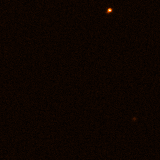
- GCN NOTICE
TITLE: GCN/SWIFT NOTICE
NOTICE_DATE: Wed 01 Sep 10 13:53:51 UT
NOTICE_TYPE: Swift-UVOT Processed Image
TRIGGER_NUM: 433065, Seg_Num: 0
POINT_RA: 27.282d {+01h 49m 08s} (J2000)
POINT_DEC: +22.702d {+22d 42' 09"} (J2000)
ROLL: 61.214d
IMG_START_DATE: 15440 TJD; 244 DOY; 10/09/01
IMG_START_TIME: 49155.68 SOD {13:39:15.68} UT, 305.3 [sec] since BAT Trigger Time
FILTER: 7, U
EXPOSURE_ID: 305041161
X_OFFSET: 559 [pixels]
Y_OFFSET: 570 [pixels]
WIDTH: 160 [pixels]
HEIGHT: 160 [pixels]
X_GRB_POS: 719
Y_GRB_POS: 730
BINNING_INDEX: 1
IM_URL: sw00433065000msuni0312.fits
SUN_POSTN: 160.62d {+10h 42m 28s} +8.19d {+08d 11' 10"}
SUN_DIST: 124.72 [deg] Sun_angle= 8.9 [hr] (West of Sun)
MOON_POSTN: 64.89d {+04h 19m 33s} +24.17d {+24d 09' 58"}
MOON_DIST: 34.29 [deg]
MOON_ILLUM: 52 [%]
GAL_COORDS: 139.95,-38.26 [deg] galactic lon,lat of the pointing direction
ECL_COORDS: 33.44, 10.71 [deg] ecliptic lon,lat of the pointing direction
COMMENTS: SWIFT-UVOT Processed Image.
COMMENTS: The GRB Position came from the Window Position in the Mode Command.
COMMENTS: The image has 2x2 binning (compression).
COMMENTS: All 4 attachments are included.
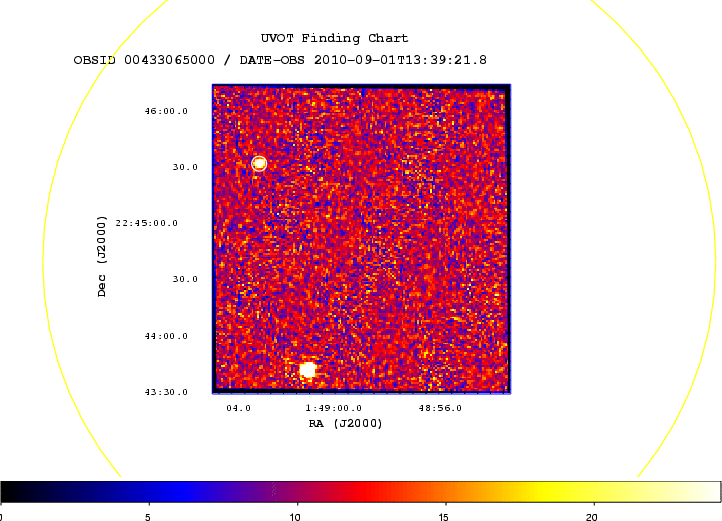
- GCN NOTICE
TITLE: GCN/SWIFT NOTICE
NOTICE_DATE: Wed 01 Sep 10 13:58:33 UT
NOTICE_TYPE: Swift-UVOT Position
TRIGGER_NUM: 433065, Seg_Num: 0
GRB_RA: 27.2641d {+01h 49m 03.38s} (J2000),
27.4122d {+01h 49m 38.93s} (current),
26.5710d {+01h 46m 17.04s} (1950)
GRB_DEC: +22.7586d {+22d 45' 30.9"} (J2000),
+22.8114d {+22d 48' 40.8"} (current),
+22.5104d {+22d 30' 37.2"} (1950)
GRB_ERROR: 0.8 [arcsec radius, statistical only]
GRB_MAG: 19.67 +/- 0.17 [mag]
FILTER: 10, White
IMG_START_DATE: 15440 TJD; 244 DOY; 10/09/01
IMG_START_TIME: 49001.00 SOD {13:36:41.00} UT, 150.6 [sec] since BAT Trigger Time
SUN_POSTN: 160.62d {+10h 42m 29s} +8.19d {+08d 11' 06"}
SUN_DIST: 124.71 [deg] Sun_angle= 8.9 [hr] (West of Sun)
MOON_POSTN: 64.93d {+04h 19m 44s} +24.17d {+24d 10' 12"}
MOON_DIST: 34.33 [deg]
MOON_ILLUM: 52 [%]
GAL_COORDS: 139.91,-38.21 [deg] galactic lon,lat of the burst (or transient)
ECL_COORDS: 33.45, 10.77 [deg] ecliptic lon,lat of the burst (or transient)
COMMENTS: SWIFT UVOT Position Notice.
COMMENTS: This Notice was ground-generated -- not flight-generated.
- GCN Circular #11159
S. Immler (CRESST/GSFC/UMD), S. D. Barthelmy (GSFC),
W. H. Baumgartner (GSFC/UMBC), A. P. Beardmore (U Leicester),
S. Campana (INAF-OAB), V. D'Elia (ASDC), P. A. Evans (U Leicester),
J. M. Gelbord (PSU), O. Godet (U Leicester), C. Gronwall (PSU),
C. Guidorzi (U Ferrara), S. T. Holland (CRESST/USRA/GSFC),
E. A. Hoversten (PSU), O. M. Littlejohns (U Leicester),
F. E. Marshall (NASA/GSFC), P. T. O'Brien (U Leicester),
J. P. Osborne (U Leicester), C. Pagani (U Leicester),
K. L. Page (U Leicester), D. M. Palmer (LANL), T. A. Pritchard (PSU),
A. Rowlinson (U Leicester), B. Sbarufatti (INAF-OAB/IASFPA),
M. H. Siegel (PSU), M. Stamatikos (OSU/NASA/GSFC) and
R. L. C. Starling (U Leicester) report on behalf of the Swift Team:
At 13:34:10 UT, the Swift Burst Alert Telescope (BAT) triggered and
located GRB 100901A (trigger=433065). Swift slewed immediately to the burst.
The BAT on-board calculated location is
RA, Dec 27.245, +22.744, which is
RA(J2000) = 01h 48m 59s
Dec(J2000) = +22d 44' 39"
with an uncertainty of 3 arcmin (radius, 90% containment, including
systematic uncertainty). The BAT light curve showed a single symmetric
peak structure with a duration of about 10 sec. The peak count rate
was ~800 counts/sec (15-350 keV), at ~1 sec after T_zero.
The XRT began observing the field at 13:36:51.0 UT, 160.6 seconds after
the BAT trigger. Using promptly downlinked data we find an uncatalogued
X-ray source with an enhanced position: RA, Dec 27.2642, 22.7584 which
is equivalent to:
RA(J2000) = 01h 49m 3.41s
Dec(J2000) = +22d 45' 30.1"
with an uncertainty of 3.0 arcseconds (radius, 90% containment). This
location is 82 arcseconds from the BAT onboard position, within the BAT
error circle. This position may be improved as more data are received;
the latest position is available at http://www.swift.ac.uk/sper.
A power-law fit to a spectrum formed from promptly downlinked event
data gives a column density consistent with the Galactic value of
7.08e+20 cm^-2 (Kalberla et al. 2005).
UVOT took a finding chart exposure of 150 seconds with the White
filter starting 147 seconds after the BAT trigger. There is a
candidate afterglow in the rapidly available 2.7'x2.7' sub-image at
RA(J2000) = 01:49:03.42 = 27.26424
DEC(J2000) = +22:45:30.8 = 22.75856 with a 90%-confidence error
radius of about 0.81 arc sec. This position is 0.6 arc sec. from the
center of the XRT-Enhanced error circle. The estimated magnitude is
19.67 with a 1-sigma error of about 0.18. No correction has been made
for the expected extinction corresponding to E(B-V) of 0.10.
Burst Advocate for this burst is S. Immler (immler AT milkyway.gsfc.nasa.gov).
Please contact the BA by email if you require additional information
regarding Swift followup of this burst. In extremely urgent cases, after
trying the Burst Advocate, you can contact the Swift PI by phone (see
Swift TOO web site for information: http://www.swift.psu.edu/too.html.)
- GCN Circular #11160
C. Guidorzi (U. Ferrara), Z. Cano, A. Melandri (LJMU),
D. Kopac (U. Ljubljana) report on behalf of a large collaboration:
The Faulkes Telescope North automatically began observing Swift
GRB 100901A (Immler et al. GCN Circ. 11159) on September 01,
13:36:29 UT, 2.32 minutes from the GRB trigger time.
We clearly identify an uncatalogued object at the following position:
RA(J2000.0): 01:49:03.41
Dec(J2000.0): +22:45:30.8
This is consistent with the UVOT candidate (GCN 11159).
Observations are going on.
- GCN Circular #11161
K.Ivanov, O.Chuvalaev, V.Poleschuk, E.Konstantinov, V.Lenok, O.Gres,
S.Yazev, N.M.Budnev,
Irkutsk State University
E. Gorbovskoy, V. Lipunov, V.Kornilov, A.Belinski, N.Shatskiy, N.Tyurina,
D.Kuvshinov, P.Balanutsa, V.V.Chazov, P.V.Kortunov, A.Kuznetsov,
D.Zimnukhov, M. Kornilov
Sternberg Astronomical Institute, Moscow State University
A. Tlatov, A.V. Parhomenko, D. Dormidontov, V.Sennik
Kislovodsk Solar Station of the Pulkovo Observatory
V.Yurkov, Yu.Sergienko, D.Varda, I.Kudelina
Blagoveschensk Educational State University, Blagoveschensk
V.Krushinski, I.Zalozhnich, T.Kopytova, A. Popov
Ural State University, Kourovka
Two MASTER robotic telescopes (MASTER-Net: http://observ.pereplet.ru)
located near Baykal Lake (Tunka) and Blagoveschensk was pointed to the
Swift GRB 100901A (Immler et al., GCN Circ 11159) 47 sec after Notice
time (103 s after trigger time) and 45 s after Notice time (101s after trigger
time).
We have a number polarization, unfiltered and R images with exposition
20, 30, 40, 60... s. but near horizont.
start UT end UT t_exp(s) mlim t_start-tGRB(s) Coadd? Filter
--------------------------------------------------------------------------
13:35:51 13:35:51 20 16.1 101.0 N Unfiltr
13:35:51 13:37:32 80 16.6 101.0 Y Unfiltr
13:35:53 13:36:13 20 16.5 103.0 N Polariz
13:35:53 13:38:02 90 17.4 103.0 Y Polariz
The message may be cited.
mailto: lipunov@sai.msu.ru
- GCN Circular #11162
E. Klunko, I. Korobtsev (ISTP), A. Pozanenko (IKI) on behalf of larger GRB
follow up collaboration report:
We observed the Swift GRB 100901A (Immler et al., GCN 11159) with
AZT-33IK telescope of Sayan observatory (Mondy) starting Sep. 01 (UT)
13:44:30. We confirm the afterglow candidate (Immler et al., GCN 11159;
Guidorzi et al., GCN 11160) at the following preliminary position
(J2000) RA=01 49 03.29 Dec +22 45 30.0. We clearly detect the afterglow in
single images of 60 s exposure obtained in R-filter.
Observations are continuing.
- GCN Circular #11163
K.Ivanov, O.Chuvalaev, V.Poleschuk, E.Konstantinov, V.Lenok, O.Gres,
S.Yazev, N.M.Budnev,
Irkutsk State University
E. Gorbovskoy, V. Lipunov, V.Kornilov, A.Belinski, N.Shatskiy, N.Tyurina,
D.Kuvshinov, P.Balanutsa, V.V.Chazov, P.V.Kortunov, A.Kuznetsov,
D.Zimnukhov, M. Kornilov
Sternberg Astronomical Institute, Moscow State University
A. Tlatov, A.V. Parhomenko, D. Dormidontov, V.Sennik
Kislovodsk Solar Station of the Pulkovo Observatory
V.Yurkov, Yu.Sergienko, D.Varda, I.Kudelina
Blagoveschensk Educational State University, Blagoveschensk
V.Krushinski, I.Zalozhnich, T.Kopytova, A. Popov
Ural State University, Kourovka
We clearly see (MASTER-Net: http://observ.pereplet.ru)
located near Baykal Lake (Tunka) and Blagoveschensk) brightenning OT at
the Swift position (Immler et al., GCN Circ 11159).
R mag = 17 (38 min after GRB time)
The message may be cited.
mailto: lipunov@sai.msu.ru
- GCN Circular #11164
R. Chornock, E. Berger (Harvard), D. Fox (Penn State), A. J. Levan (U. Warwick),
N. R. Tanvir, and K. Wiersema (U. Leicester) report on behalf of a larger
collaboration:
We obtained spectroscopy of the optical afterglow (Immler et al., GCN 11159;
Guidorzi et al., GCN 11160; Ivanov et al., GCN 11161; Klunko et al., GCN 11162)
of GRB 100901A (Immler et al., GCN 11159) using GMOS on the Gemini-North 8-m
telescope starting on 2010 September 1.61 UT. A set of four 400s observations
were obtained covering the wavelength range 3825-6675 Angstroms. Numerous
absorption lines are present. The highest redshift system is at z=1.408, with
many absorptions from Fe II, Al II, and Si II. The presence of several Fe II*
absorptions establishes this as the redshift of the host galaxy of GRB 100901A.
Two intervening systems at z=1.315 and 1.318 also have absorptions from Mg II
and Fe II.
We thank A. Stephens and the Gemini staff for their help in obtaining these
observations.
- GCN Circular #11165
E. Gorbovskoy, V. Lipunov, V.Kornilov, A.Belinski, N.Shatskiy, N.Tyurina,
D.Kuvshinov, P.Balanutsa, V.V.Chazov, P.V.Kortunov, A.Kuznetsov,
D.Zimnukhov, M. Kornilov
Sternberg Astronomical Institute, Moscow State University
K.Ivanov, O.Chuvalaev, V.Poleschuk, E.Konstantinov, V.Lenok, O.Gres,
S.Yazev, N.M.Budnev,
Irkutsk State University
V.Yurkov, Yu.Sergienko, D.Varda, I.Kudelina
Blagoveschensk Educational State University, Blagoveschensk
A. Tlatov, A.V. Parhomenko, D. Dormidontov, V.Sennik
Kislovodsk Solar Station of the Pulkovo Observatory
V.Krushinski, I.Zalozhnich, T.Kopytova, A. Popov
Ural State University, Kourovka
We clearly see (MASTER-Net: http://observ.pereplet.ru, Tunka)
OT after 386 s (T-T_trigger) at the
Swift position (Immler et al., GCN Circ 11159) and strongly brighter than
UVOT estimation (Immler et al., GCN Circ 11159).
After this time we see power low decay F ~ t_(-alpha), with alpha ~
0.5+-0.2.
This is preliminary result. Observations are continued at Tunka, Ural
and Kislovodsk in different filters.
The message may be cited.
mailto: lipunov@sai.msu.ru
- GCN Circular #11166
M. Andreev, A. Sergeev (Terskol Branch of Institute of Astronomy), A.
Pozanenko (IKI) on behalf of larger GRB follow up collaboration report:
We started observation of the Swift GRB 100901A (Immler et al., GCN 11159)
with the Z-600 telescope of Mt.Terskol observatory in R-filter on Sep.01
(UT) 17:50. In a combined image we clearly detect the afterglow (Immler et
al., GCN 11159; Guidorzi et al., GCN 11160; Ivanov et al., GCN 11161; Klunko
et al., GCN 11162).
Preliminary photometry is based on the reference star USNO-B1.0
#1127-0027231 RA(J2000) = 01 49 06.78 Dec(J2000) = +22 47 03.3 assuming
R=15.37:
T0+ Filter, Exposure, OT
(d) (s)
0.1821 R 5x60 17.28 +/-0.03
The finding chart can be found at
http://grb.rssi.ru/GRB100901A/GRB100901A_R_100901_Terskol.jpg
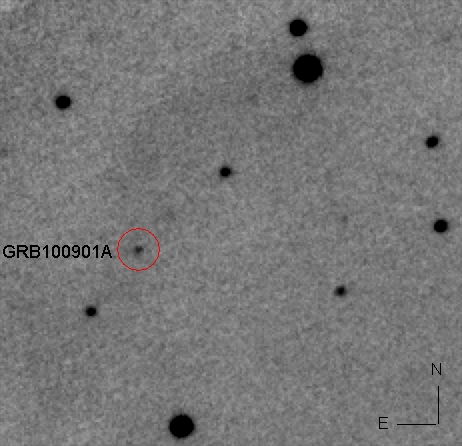
- GCN Circular #11167
J.P. Osborne, A.P. Beardmore, P.A. Evans and M.R. Goad (U. Leicester)
report on behalf of the Swift-XRT team.
Using 52 s of XRT Photon Counting mode data and 1 UVOT
images for GRB 100901A, we find an astrometrically corrected X-ray
position (using the XRT-UVOT alignment and matching UVOT field sources
to the USNO-B1 catalogue): RA, Dec = 27.26485, +22.75850 which is equivalent
to:
RA (J2000): 01h 49m 3.56s
Dec (J2000): +22d 45' 30.6"
with an uncertainty of 2.2 arcsec (radius, 90% confidence).
This position may be improved as more data are received. The latest
position can be viewed at http://www.swift.ac.uk/xrt_positions. Position
enhancement is described by Goad et al. (2007, A&A, 476, 1401) and Evans
et al. (2009, MNRAS, 397, 1177).
This circular was automatically generated, and is an official product of the
Swift-XRT team.
- GCN Circular #11168
M. Andreev, A. Sergeev (Terskol Branch of Institute of Astronomy) and A.
Pozanenko (IKI) on behalf of larger GRB follow up collaboration report:
We are continuing observations of the Swift GRB 100901A (Immler et al., GCN
11159) with the Z-600 telescope of Mt.Terskol observatory in R-filter
(Andreev et al., GCN 11166). In a combined image at mid time Sep. 01 (UT)
20:09 we still detect bright afterglow (Immler et al., GCN 11159; Guidorzi
et al., GCN 11160; Ivanov et al., GCN 11161; Klunko et al., GCN 11162).
Preliminary photometry is based on the reference star USNO-B1.0
#1127-0027231 RA(J2000) = 01 49 06.78 Dec(J2000) = +22 47 03.3 assuming
R=15.37:
T0+ Filter, Exposure, OT
(d) (s)
0.2742 R 5x60 17.05 +/-0.02
- GCN Circular #11169
T. Sakamoto (GSFC/UMBC), S. D. Barthelmy (GSFC), W. H. Baumgartner (GSFC/UMBC),
J. R. Cummings (GSFC/UMBC), N. Gehrels (GSFC), H. A. Krimm (GSFC/USRA),
S. Immler (CRESST/GSFC/UMD), C. B. Markwardt (GSFC/UMD), D. M. Palmer (LANL),
M. Stamatikos (OSU), J. Tueller (GSFC), T. N. Ukwatta (GWU)
(i.e. the Swift-BAT team):
Using the data set from T-240 to T+663 sec from recent telemetry downlinks,
we report further analysis of BAT GRB 100901A (trigger #433065)
(Immler, et al., GCN Circ. 11159). The BAT ground-calculated position is
RA, Dec = 27.252, 22.751 deg, which is
RA(J2000) = 01h 49m 00.5s
Dec(J2000) = +22d 45' 02.9"
with an uncertainty of 3.5 arcmin, (radius, sys+stat, 90% containment).
The partial coding was 40%.
The mask-weighted light curve shows two main peaks. The first starts at
~T-5 sec, peaks at ~T+5 sec, and ends at ~T+10 sec. The second starts
at ~T+300 sec, peaks at ~T+390, and ends at ~T+490 sec. We note that the
burst location went out of the BAT FoV at T+650 sec during a slew
due to an observing constraint. T90 (15-350 keV) is 439 +- 33 sec
(estimated error including systematics).
The time-averaged spectrum from T-2.4 to T+471.8 sec is best fit by a simple
power-law model. The power law index of the time-averaged spectrum is
1.52 +- 0.21. The fluence in the 15-150 keV band is 2.1 +- 0.3 x 10^-6 erg/cm2.
The 1-sec peak photon flux measured from T-1.81 sec in the 15-150 keV band
is 0.8 +- 0.2 ph/cm2/sec. All the quoted errors are at the 90% confidence
level.
The results of the batgrbproduct analysis are available at
http://gcn.gsfc.nasa.gov/notices_s/433065/BA/
- GCN Circular #11170
A. De Cia, P.M. Vreeswijk and P. Jakobsson (University of
Iceland) report:
We observed the field of GRB 100901A (Immler et al., GCN 11159)
with the NOT equipped with ALFOSC in good weather conditions.
Observations were carried out in the R filter for 15 minutes,
with mean time 12.13 hours after the GRB trigger.
We measure R=17.3 for the afterglow, not corrected for Galactic
extinction, calibrated against the USNO-B1.0 1127-0027231
reference star (R=15.37) used by Andreev et al., GCN 11166 and
GCN 11168.
time after trigger exposure (s) R mag
12.13 hours 3 x 300 17.3
We acknowledge the careful assistence of the NOT staff, in
particular Tapio Pursimo.
- GCN Circular #11171
K.L. Page (U. Leicester) and S. Immler (CRESST/GSFC/UMD) report on behalf
of the Swift-XRT team:
We have analysed 13 ks of XRT data for GRB 100901A (Immler et al., GCN
Circ. 11159), from 128 s to 33.2 ks after the BAT trigger. The data
comprise 448 s in Windowed Timing (WT) mode (the first 9 s were taken
while Swift was slewing) with the remainder in Photon Counting (PC) mode.
The enhanced XRT position for this burst was given by Osborne et al. (GCN.
Circ 11167).
The first snapshot (data collected until ~620 s after the trigger)
consists of a number of superimposed flares, with the main peak around 410
s; this peak was also seen in the BAT data (Sakamoto et al., GCN Circ.
11169). The light curve then shows a decaying trend with alpha = 0.74 +/-
0.12, until around 12 ks, after which there is a small rebrightening, to a
plateau level of around 0.3 count s^-1.
A spectrum formed from the WT mode data can be fitted with an absorbed
power-law with a photon spectral index of 1.68 (+/-0.04). The best-fitting
absorption column is 3.6 (+0.7, -0.6) x 10^21 cm^-2, at a redshift of
1.408 (Chornock et al., GCN Circ 11164), in addition to the Galactic value
of 7.1 x 10^20 cm^-2 (Kalberla et al. 2005). The PC mode spectrum has a
photon index of 2.19 (+/-0.07) and a best-fitting absorption column of 3.9
(+/-0.9) x 10^21 cm^-2 (in addition to the Galactic vale). The counts to
observed (unabsorbed) 0.3-10 keV flux conversion factor deduced from this
spectrum is 3.5 x 10^-11 (5.1 x 10^-11) erg cm^-2 count^-1.
Because of the rebrightening/plateau shape of the light curve at this time, we
cannot sensibly predict the count rate at 24 hours.
The results of the XRT-team automatic analysis are available at
http://www.swift.ac.uk/xrt_products/00433065.
This circular is an official product of the Swift-XRT team.
- GCN Circular #11172
D. Kuroda, K. Yanagisawa, Y. Shimizu, H. Toda (OAO, NAOJ),
S. Nagayama (NAOJ), M. Yoshida (Hiroshima), K. Ohta (Kyoto)
and N. Kawai(Tokyo Tech)
report on behalf of the MITSuME collaboration:
We observed the field of GRB 100901A (Immler et al., GCN 11159)
with the optical three color (g', Rc and Ic) CCD camera attached
to the MITSuME 50cm telescope of Okayama Astrophysical Observatory.
The observation started on 2010-09-1 13:36:08 UT (~2.0 min after
the burst). We detected the previously reported afterglow
(Immler et al., GCN 11159; Guidorzi et al., GCN 11160;
Klunko et al., GCN 11162; Ivanov et al., GCN 11165;
Andreev et al., GCN 11166, GCN 11168; De Cia et al., GCN 11170)
in all the three bands. Our results show that the brightness of
the afterglow began to increase at ~0.14 days after the burst.
Photometric results and three sigma upper limits of the OT are
listed below. We used GSC2.3 catalog for flux calibration.
#T0+[day] MID-UT T-EXP[sec] g' g'_err Rc Rc_err Ic Ic_err
----------------------------------------------------------------------
0.01195 13:51:23 1560.0 18.6 0.5 17.4 0.1 16.8 0.2
0.03343 14:22:18 1560.0 18.1 0.1 17.9 0.1 17.4 0.1
0.05475 14:53:00 1560.0 18.7 0.1 18.5 0.1 17.6 0.1
0.07594 15:23:32 1440.0 18.7 0.1 18.4 0.1 18.0 0.2
0.09685 15:53:38 1500.0 18.9 0.1 18.5 0.1 18.0 0.2
0.11790 16:23:57 1560.0 19.1 0.2 18.7 0.2 17.9 0.2
0.13912 16:54:30 1560.0 18.8 0.1 18.4 0.1 17.8 0.1
0.16013 17:24:46 1500.0 18.7 0.1 18.0 0.1 17.2 0.1
0.18107 17:54:55 1560.0 18.2 0.1 17.6 0.1 17.1 0.1
0.20223 18:25:23 1500.0 18.0 0.1 17.7 0.1 17.0 0.1
0.22363 18:56:12 1500.0 18.2 0.1 17.6 0.1 17.0 0.1
----------------------------------------------------------------------
T0+ : Elapsed time after the burst [day]
T-EXP: Total Exposure time [sec]
- GCN Circular #11173
Veli-Pekka Hentunen, Markku Nissinen and Tuomo Salmi (Taurus Hill
Observatory, Varkaus, Finland) report:
Taurus Hill Observatory (A95, Varkaus, Finland) C-14 telescope and SBIG
ST-8XME CCD camera were used to detect GRB 100901A optical afterglow.
The observations were started at 2010-09-01 21:08:30 (UT) and stopped at
2010-09-02 01:11:13 (UT). A number of unfiltered and BVR observations with
varying exposure times were made. The afterglow was detected at following
position RA 1 49 03.45 and DEC +22 45 30.5 consistent those given by Immler
s. et al. (GCN 11159) and Guidorzi C. et al. (GCN 11160) to within positional
errors.
The following magnitudes were obtained from the observations using USNO-B1.0
1127-0027231 (R = 15.37 and B = 16.38)) as the comparison:
+T0 (hour) Filter Exp (sec) Mag Mag err Limit
7.606 unfiltered 2x120 17.1 0.1 18.4
7.678 unfiltered 2x120 17.2 0.2 18.5
10.607 unfiltered 3x300 17.3 0.1 19.6
11.141 Rc 3x300 17.4 0.1 20.0
11.228 B 3x300 18.1 0.2 19.1
A jpg color image of the 4x300sec observations is available at the
following URL:
http://cutenews.kassiopeia.net/data/upimages/GRB100901A_LRGB_web_nuoli.jpg
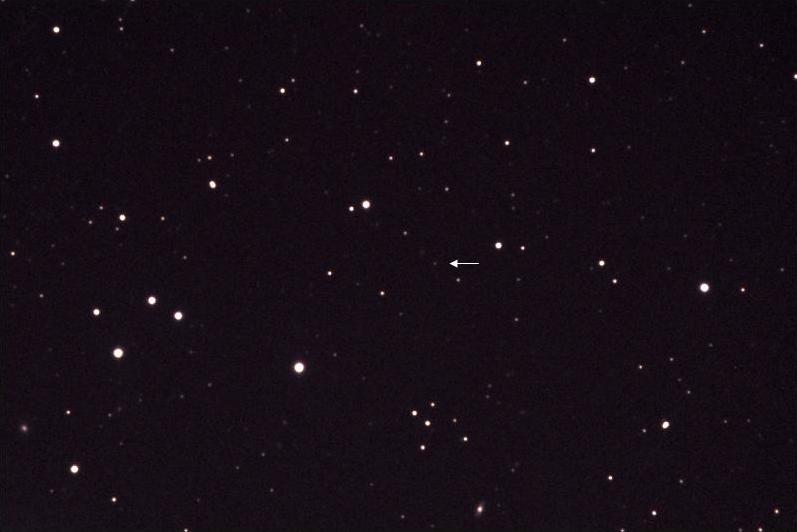
- GCN Circular #11174
Adria C. Updike, Dieter H. Hartmann (Clemson University) and William Keel,
Erin Darnell (U Alabama) report:
We observed the field of GRB 100901A (Immler et al., GCN 11159) with the
0.9m SARA-North telescope located at KPNO beginning 18 hours and 45
minutes after the trigger under good conditions. In 240s exposures, we
clearly detect the afterglow in all images.
Filter Mag Mag error UT Start
---------------------------------------
B 18.7 0.1 08:20
V 18.2 0.1 08:24
R 18.0 0.1 08:28
I 17.9 0.1 08:32
Magnitudes are reported relative to the USNO B1.0 and NOMAD catalogs field
stars. Observations in all bands continued for 4 hours. Further
observations are planned.
- GCN Circular #11175
D.K. Sahu, B.C. Bhatt, Sonam Arora and Pepsi Anto (IIA, Bangalore) report.
Optical afterglow of GRB 100901A (Immler et al. GCN 11159)
was obsrved with the 2m. Himalayan Chandra Telescope of the
Indian Astronomical Observatory, Hanle, India. A series of
exposures were taken in Bessell V, R and I bands, between
17:35 UT and 22:15 UT on 01/09/2010. The optical afterglow was
detected in all our frames. The preliminary R and I magnitudes
of the optical afterglow calibrated using USNO B1.0 1127-0027231
reference star (R=15.37, I=15.13) is as under:
Mid UT Exposure Filter Mag
17:42 300sec R 17.34 +/- 0.05
19:44 300sec R 17.03 +/- 0.05
22:05 300sec R 17.08 +/- 0.04
17:51 300sec I 17.05 +/- 0.05
19:51 300sec I 16.76 +/- 0.04
This message may be cited.
- GCN Circular #11176
T. A. Pritchard (PSU) and Immler (CRESST/GSFC/UMD)
report on behalf of the Swift/UVOT team:
The Swift/UVOT began settled observations of the field of GRB 100901A
147 s after the BAT trigger (Immler et al., GCN Circ. 11159).
We detect an object not present in the DSS in all filters within 0.1
arcsec of the Enhanced Swift-XRT position (Osborne et al., GCN Circ. 1116=
9)
Preliminary magnitudes and 3-sigma upper limits using the UVOT
photometric system (Poole et al. 2008, MNRAS, 383, 627) for the first
finding chart (FC) exposure and subsequent exposures are:
Filter T_start(s) T_stop(s) Exp(s) Mag
white (FC) 147 297 147 19.55 =B1 0.19
u (FC) 305 555 246 17.52 =B1 0.10
white 585 605 20 18.58 =B1 0.32
white 4849 5051 198 18.66 =B1 0.07
b 561 581 19 17.85 =B1 0.30
b 4644 4844 197 18.69 =B1 0.11
u 305 555 246 17.52 =B1 0.10
u 4439 4639 197 18.08 =B1 0.10
v 129 139 10 >17.21
v 3824 4024 197 18.50 =B1 0.21
w1 4234 4434 197 18.53 =B1 0.16
m2 4029 4229 197 19.22 =B1 0.32
w2 611 626 15 >17.6
w2 5055 5255 197 >20.04
w2 9620 10520 885 20.73 =B1 0.32
The values quoted above are not corrected for the Galactic extinction
due to the reddening of E(B-V) =3D 0.10 in the direction of the burst
(Schlegel et al. 1998).
- GCN Circular #11177
D. Kopac, B. Dintinjana and A. Gomboc (U. Ljubljana) report:
We observed the field of GRB 100901A (Immler et al., GCN 11159) with the
0.7m Vega telescope located in Ljubljana, starting at 20:31:31 UT on 2010
September 01, approx. 7 hours after the trigger. We took 10 images in R
band with exposure time 180s and we clearly detect the optical afterglow
(Guidorzi et al., GCN 11160). Our preliminary photometry yields
Mid time from Filter Magnitude
trigger (days)
-------------------------------------
0.302 R 17.2 +- 0.1
-------------------------------------
Magnitude is calibrated against the USNO-B1.0 1127-0027192 reference star
(R2=17.58) and is not corrected for Galactic extinction.
- GCN Circular #11178
E. Gorbovskoy, V. Lipunov, V.Kornilov, A.Belinski, N.Shatskiy, N.Tyurina,
D.Kuvshinov, P.Balanutsa, V.V.Chazov, P.V.Kortunov, A.Kuznetsov,
D.Zimnukhov, M. Kornilov
Sternberg Astronomical Institute, Moscow State University
K.Ivanov, O.Chuvalaev, V.Poleschuk, E.Konstantinov, V.Lenok, O.Gres,
S.Yazev, N.M.Budnev,
Irkutsk State University
V.Yurkov, Yu.Sergienko, D.Varda, I.Kudelina
Blagoveschensk Educational State University, Blagoveschensk
A. Tlatov, A.V. Parhomenko, D. Dormidontov, V.Sennik
Kislovodsk Solar Station of the Pulkovo Observatory
V.Krushinski, I.Zalozhnich, T.Kopytova, A. Popov
Ural State University, Kourovka
We (MASTER-Net: http://observ.pereplet.ru, Tunka, Ivanov et al.,
GCN Circ 11161) clearly detected optical flare (maxmag~17.0,unfiltered) at 426+-40 s after
trigger time (Immler et al., GCN Circ 11159) synchronously with
Xray flare (Page et al., GCN Circ 11171).
We have ~ 11 hours Unfiltered, R,I, Polarization continuously
observations on same telescope systems. The redaction is continued.
The first 10 000 s relative optical flux light curve is
available at http://observ.pereplet.ru/images/GRB100901A/opt_flux_lc.png
The message may be cited.
mailto: lipunov@sai.msu.ru
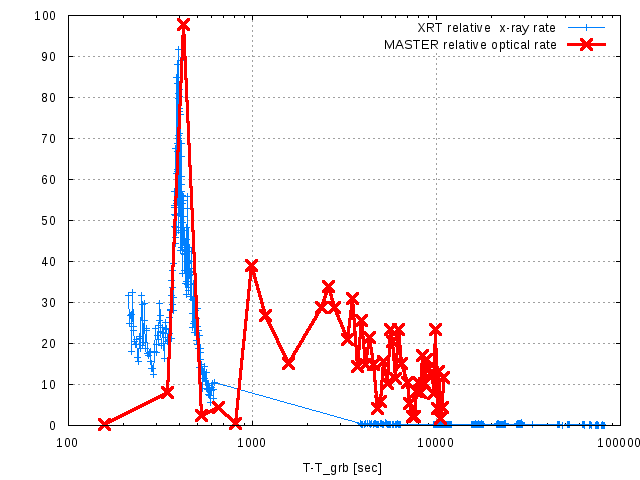
- GCN Circular #11179
S. B. Pandey and W. Zheng (U Mich), report on behalf of the ROTSE
collaboration:
Due to bad weather conditions, the ROTSE-3a telescope at Siding Springs
Observatory, Australia did not respond to GRB 100901A (Swift trigger
433065,
Immler S. et al., GCN 11159). Automated re-pointing of ROTSE-3c at the
H.E.S.S. site at Mt. Gamsberg, Namibia and ROTSE-3b at the McDonald
Observatory, Texas observed the optical afterglow starting ~ 8.6 to 22.0
hours after the burst.
The optical afterglow was detected in all the stacked frames. The optical
afterglow candidate appears to decay with a power-law index of ~1.2 at
later epochs. Further imaging is ongoing.
- GCN Circular #11180
R. S=E1nchez-Ram=EDrez, J.C. Tello, A. Sota, J. Gorosabel, A.J. Castro-Ti=
rado
(IAA-CSIC, Granada), report on behalf of a larger collaboration:
"We have taken several series of BVRI-band images of the Swift GRB 100901A
(Immler et al. GCNC 11159) optical afterglow (Guidorzi et al. GCNC
11160) with the 1.5m telescope at Observatorio de Sierra Nevada, Spain.
The afterglow is well detected in the four bands, with preliminary
average magnitudes (calibrated against USNO B1.0 and GSC 3.2 stars)
of
B~18.0 (Sep 2.021 UT), V~17.4 (Sep 2.035 UT), R~17.3 (Sep 2.003 UT) and
I~17.3 (Sep 2.049 UT)."
- GCN Circular #11184
L. Elenin, I. Molotov (ISON), A. Pozanenko (IKI) report on behalf of larger
GRB follow-up collaboration:
We observed the field of the Swift GRB 100901A (Immler et al. GCN Circ.
11159)
with 0.45-m telescope of ISON-NM observatory on Sep. 02 (UT) 09:55:53 -
10:22:06.
The afterglow (Immler et al., GCN 11159; Guidorzi et al., GCN 11160; Ivanov
et al., GCN 11161;
Klunko et al., GCN 11162) is well detected. For the preliminary photometry
of unfiltered image
we used USNO-B1.01127-0027229 field stars, assuming R=16.16:
T-T0 filter exposure mag. mag. error
--------------------------------------------------------------
0.8561 W 20x60 17.82 +/- 0.03
- GCN Circular #11186
D. Kuroda, K. Yanagisawa, Y. Shimizu, H. Toda (OAO, NAOJ),
S. Nagayama (NAOJ), M. Yoshida (Hiroshima), K. Ohta (Kyoto)
and N. Kawai(Tokyo Tech)
report on behalf of the MITSuME collaboration:
The reference catalog reported in GCN 11172 is incorrect.
We used SDSS calalog for flux calibration.
- GCN Circular #11187
D. A. Kann, S. Klose, U. Laux, and B. Stecklum (TLS Tautenburg) report:
We observed the afterglow of the double-peaked Swift GRB 100901A (Immler
et al., GCN 11159) with the TLS 1.34m Schmidt telescope through several
holes in the persistent cloud cover. Otherwise, conditions were excellent.
We clearly detect the afterglow in all single 300 sec frames at high
signal-to-noise (statistical error 0.03 - 0.04 mag). In comparison to fiv=
e
USNOB1.0 (R2 magnitude) stars, we find:
time Rc dRc
1.382892 18.93 0.13
1.386920 19.00 0.15
1.422927 19.04 0.13
1.426955 19.13 0.14
We compile all available GCN data (Klunko et al., GCN 11162; Gorbovsky et
al., GCN 11163; Andreev et al., GCN 11166; Andreev et al., GCN 11168; De
Cia et al., GCN 11170; Kuroda et al., GCN 11172; Hentunen et al., GCN
11173; Updike et al., GCN 11174; Sahu et al., GCN 11175; Pritchard &
Immler, GCN 11176; Kopac et al., GCN 11177; Ivanov et al., GCN 11178;
S=E1nchez-Ram=EDrez et al., GCN 11180; Elenin et al., GCN 11184) and can
make
the following statements on the light curve evolution of this
extraordinary burst:
The light curve shows three peaks. The first is the prompt flare reported
by Ivanov et al., GCN 11178 (it should also be seen strongly in the UVOT u
band event mode finding chart). The second peak is at ~ 0.026 days,
reported by Gorbovsky et al., GCN 11163. Then another rebrightening sets
in (Kuroda et al., GCN 11172), which peaks at about 0.35 days (e.g.,Sahu
et al., GCN 11175, also seen strongly in the X-rays, Page & Immler, GCN
11171) . The afterglow begins to decay after that, and we find that the
decay seems to have become steeper between the latest reported data
(Updike et al., GCN 11174; Elenin et al., GCN 11184) and our detections at
~1.4 days. This may possibly be a jet break. Note that the R1 magnitudes
are systematically ~ 0.2 mag brighter and thus the significance of the
break is reduced if this calibration is used instead.
Observationally, the late rebrightening makes this one of the brightest
afterglows ever detected beyond 0.35 days, on par with that of GRB 060729
and several others.
Comparing the extraordinary light curve evolution with our afterglow data
base (Kann et al. 2010, ApJ, 720, 1513), we find that the evolution is
remarkably similar to that of two other afterglows, namely GRB 060906
(Cenko et al. 2009, ApJ, 693, 1484) and GRB 970508 (e.g., Garcia et al.
1998, ApJ, 500, L105). In the extinction-corrected z = 1 system (we assume
beta = 0.6, A_V = 0.1 - typical values - for GRB 100901A, and use z =
1.408, Chornock et al., GCN 11164), we find that the large-amplitude
optical flares of these three afterglows can be brought to a reasonable
match if we shift the GRB 060906 light curve by (Delta t = x 4.8; Delta
mag = + 0.4) (it is faster and brighter) and that of GRB 970508 by (Delta
t = / 8.2; Delta mag = - 3.7) (it is slower and fainter). In log-log
space, all three rebrightenings look remarkably similar. GRB 100901A and
GRB 060906 match strongly except that the rebrightening of GRB 060906 has
a lower total amplitude - the pre- and post-rebrightening decay slopes are
strongly similar. For GRB 970508, the optical flare evolves faster, also,
the pre-flare evolution is a flat plateau. The post-flare decay is again
very similar. Pandey & Zheng (GCN 11179) report a post-flare decay of
alpha ~ 1.2 for GRB 100901A, and Zeh et al. 2006, ApJ, 637, 889 indeed
find alpha = 1.24 +/- 0.01 for GRB 970508!
Finally, we point out that the strong, late optical flare may be an energy
injection, and the shells which have produced this refreshed shock may be
the same ones that created the second BAT flare at 390 seconds (Sakamoto
et al., GCN 11169) which also was seen in the optical (Gorbovsky et al.,
GCN 11163). Such reverberation effects have been discussed by Vestrand et
al. 2006, Nature, 442, 172 (GRB 050820A) as well as Guidorzi et al. 2007,
A&A, 474, 793 (GRB 070311).
Further optical and especially NIR follow-up is strongly encouraged.
Monitoring in Tautenburg will continue in the next days if weather
permits.
This message may be cited.
- GCN Circular #11189
D. Kuroda, K. Yanagisawa, Y. Shimizu, H. Toda (OAO, NAOJ),
S. Nagayama (NAOJ), M. Yoshida (Hiroshima), K. Ohta (Kyoto)
and N. Kawai(Tokyo Tech)
report on behalf of the MITSuME collaboration:
We observed the field of GRB 100901A (Immler et al., GCN 11159)
with the optical three color (g', Rc and Ic) CCD camera attached
to the MITSuME 50cm telescope of Okayama Astrophysical Observatory.
The observation started on 2010-09-2 16:51:50 UT (~1.14 day after
the burst). We detected the previously reported afterglow
(Immler et al., GCN 11159; Guidorzi et al., GCN 11160; Klunko et al.,
GCN 11162; Ivanov et al., GCN 11165; Andreev et al., GCN 11166,
GCN 11168; De Cia et al., GCN 11170; Kuroda et al., GCN 11172) in
all the three bands.
Photometric results of the OT are listed below.
The magnitudes are obtained from the sum of exposures. No significant
variation was detected during these exposures, though the S/N was not
so good. We used SDSS catalog for flux calibration.
#T0+[day] MID-UT T-EXP[sec] g' g'_err Rc Rc_err Ic Ic_err
----------------------------------------------------------------------
1.17902 17:51:57 6060.0 19.4 0.1 19.0 0.1 18.5 0.1
----------------------------------------------------------------------
T0+ : Elapsed time after the burst [day]
T-EXP: Total Exposure time [sec]
- GCN Circular #11190
M. Yoshida, M. Sasada, T. Komatsu and K. S. Kawabata (HASC, Hiroshima
University)
We performed R band imaging observation of the optical afterglow of
GRB 100901A (Immler et al., GCN 11159) with the 1.5m Kanata telescope
of Hiroshima University.
The observation was made from 2010-09-02 15:07:24 UT (~1.06 day after
the burst) to 15:50:33 UT. The previously reported afterglow (e.g
Immler et al. GCN 11159; Kuroda et al. GCN 11172; or Kann et al.
GCN 11187) was clearly detected. The afterglow showed a marginal
increasing trend in brightness within this observation.
Photometric results of the afterglow are listed below. We used USNO-
B1.0 1127-0027231 (R = 15.37) for flux calibration.
#T0+[day] MID-UT T-EXP[sec] Rc err
-----------------------------------------------
1.070266 15:15:21 900.0 18.62 0.10
1.081620 15:31:42 900.0 18.60 0.07
1.096759 15:53:30 900.0 18.54 0.04
-----------------------------------------------
T0+ : Elapsed time after the burst [day]
T-EXP: Total Exposure time [sec]
- GCN Circular #11191
M. Andreev, A. Sergeev (Terskol Branch of Institute of Astronomy) and
A.Pozanenko (IKI) on behalf of larger GRB follow up collaboration report:
We are continuing observations of the Swift GRB 100901A (Immler et al., GCN
11159) with the Z-600 telescope of Mt.Terskol observatory in R-filter
(Andreev et al., GCN 11166). In a combined image at mid time Sep. 03 (UT)
00:36 we detect afterglow (Immler et al., GCN 11159; Guidorzi et al., GCN
11160; Ivanov et al., GCN 11161; Klunko et al., GCN 11162).
In comparison with our previous photometry (Andreev et al., GCNs 11166,
11168) below we used several reference stars of SDSS DR7 and Lupton
transformation ugriz -> BVRI:
T0+ Filter, Exposure, OT
(d) (s)
1.4599 R 10x120 19.22 +/- 0.05
The photometry above is consistent with steady decay based on early
photometry (Kann et al, GRB 11187). We note however the systematic faintness
of about ~0.25m in SDSS DR7 in comparison with USNO-B1.0 R2 which can
explain possible contradiction of MITSUME observation calibrated against
SDSS (Kuroda et al, GCN 11189) and photometry reported in Yoshida et al
(GCN 11190). Detailed calibration of the field stars is necessary.
- GCN Circular #11197
D.K. Sahu, Sonam Arora, N. Shantikumar Singh and Sreeja S. Kartha
(IIA, Bangalore) report.
We observed the optical afterglow of GRB 100901A (Immler et al., GCN 11159)
in Bessell V, R, and I bands with the 2m. Himalayan Chandra Telescope of
the Indian Astronomical Observatory, Hanle, India. Observations were made
between 18:43 UT and 19:50 UT on 02/09/2010. The optical afterglow was
detected in our individual frames of 300sec each in R and I bands.
The preliminary R and I magnitudes of the optical afterglow
calibrated using USNO B1.0 1127-0027231 reference
star (R=15.37, I=15.13) is as under:
Mid UT Exposure Filter Mag
18:50 3X300sec R 18.71 +/- 0.10
19:12 3X300sec I 17.51 +/- 0.15
- GCN Circular #11198
T. N. Ukwatta (GWU/GSFC), T. Sakamoto (GSFC/UMBC), N. Gehrels (GSFC),
and K. S. Dhuga (GWU)
We observed the Swift GRB 100901A (Immler et al., GCN 11159)
with the Lightbuckets 0.61m rental telescope LB-0001 in Rodeo, NM,
USA. Under good weather conditions, observations were carried out in
the R filter starting Sep. 02 (UT) 07:05 (~ 17.5 hours after
the GRB trigger) and a followup observation was performed on
Sep. 03 (UT) 07:01 under acceptable weather conditions.
The burst afterglow is clearly detected with a R magnitude of ~18.05
in the first observation. The afterglow, not corrected for Galactic
extinction, is calibrated against the USNO-B1.0 R1 mag catalog.
Time after trigger Exposure (s) R Magnitude
17.5 hours (0.7 days) 3 x 60 ~ 18.05
41 hours (1.7 days) 10 x 60 > 19.1
We acknowledge the helpful assistance of the Lightbuckets staff, in
particular LightBuckets CEO Stephen G. Cullen.
- GCN Circular #11200
M. Andreev, A. Sergeev (Terskol Branch of Institute of Astronomy),
A.Pozanenko (IKI), N. Parakhin, S. Velichko, N. Borachok (IC AMER)
V. Petkov (Baksan Neutrino Observatory INR RAS) on behalf of larger GRB
follow up collaboration report:
We performed multicolor observations of the afterglow (Immler et al., GCN
11159; Guidorzi et al., GCN 11160; Ivanov et al., GCN 11161; Klunko
et al., GCN 11162) of the Swift GRB 100901A (Immler et al., GCN 11159) with
the Zeiss-2000 and Meade-35 telescopes of Mt.Terskol of the first day after
burst onset. The afterglow photometry is based on several reference stars
of SDSS DR7 and Lupton transformation ugri -> BV:
T0+ Filter, OT
(d)
Telescope: Meade-35
0.3527 V 17.80+/-0.05
Telescope: Zeiss-2000
0.3704 B 18.11+/- 0.02
0.4490 B 18.45+/- 0.02
0.4579 V 18.06+/- 0.02
0.4634 r(Gunn) 17.85+/- 0.02
0.4714 g(Gunn) 18.37+/- 0.02
The photometry is still preliminary and can be updated later.
- GCN Circular #11201
M. Andreev, A. Sergeev (Terskol Branch of Institute of Astronomy) and
A.Pozanenko (IKI) on behalf of larger GRB follow up collaboration report:
We are continuing observations of the Swift GRB 100901A (Immler et al., GCN
11159) with the Z-600 telescope of Mt.Terskol observatory in R-filter. In
combined images we still detect afterglow (Immler et al., GCN 11159). The
photometry is based on several reference stars of SDSS DR7 and Lupton
transformation griz -> R used in our previous reports (GCNs 11191, 11200):
T0+ Filter, Exposure, OT
(d) (s)
2.4073 R 15x120 20.13 +/-0.12
2.4282 R 15x120 20.28 +/-0.16
- GCN Circular #11205
D. Kuroda (OAO, NAOJ), H. Hanayama, T. Miyaji, J. Watanabe(IAO, NAOJ),
K. Yanagisawa (OAO, NAOJ), M. Yoshida (Hiroshima), K. Ohta (Kyoto)
and N. Kawai(Tokyo Tech) report on behalf of the MITSuME collaboration:
We observed the field of GRB 100901A (Immler et al., GCN 11159)
with the optical three color (g', Rc and Ic) CCD camera attached
to the Murikabushi 1m telescope of Ishigakijima Astronomical
Observatory.
Our observations started on 2010-09-02 13:22:45 UT (~1.0 day after the
burst) and 2010-09-03 15:24:41 UT (~2.1 day after the burs). We detected
the previously reported afterglow (Immler et al., GCN 11159;
Guidorzi et al., GCN 11160; Kuroda et al., GCN 11172; Kuroda et al.,
GCN 11189; Ukawatta et al., GCN 11198) in all the three bands.
Photometric results of the OT are listed below.
We used SDSS catalog for flux calibration.
#T0+[day] MID-UT T-EXP[sec] g' g'_err Rc Rc_err Ic Ic_err
----------------------------------------------------------------------
1.04604 14:40:28 1560.0 19.49 0.04 18.86 0.04 18.25 0.05
1.08548 15:37:16 1560.0 19.59 0.04 18.93 0.04 18.41 0.06
1.14442 17:02:08 1500.0 19.64 0.05 19.11 0.04 18.50 0.07
2.13035 16:41:52 4020.0 20.71 0.08 19.96 0.06 20.04 0.17
----------------------------------------------------------------------
T0+ : Elapsed time after the burst [day]
T-EXP: Total Exposure time [sec]
- GCN Circular #11208
Myungshin Im, Changsu Choi, Hyunsung Jun, Eugene Kang (CEOU/Seoul
National University), Y. Urata (NCU), P. Choi (Pomona College),
T. Sakamoto (NASA/GSFC), N. R. Tanvir (U. Leicester), and A. Levan
(U. Warwick) on behalf of a larger collaboration
We observed GRB 100901A (Immler et al. GCN 11159) in z, Y, J, H,
and K filters using UKIRT. The observation started at Sept. 04,
10:49:31 UT or roughly 2.88 days after the BAT alert.
We detect the afterglow in images in all the filters,
with a preliminary magnitude of K=17.82 +- 0.2 mag (Vega)
calibrated against a 2MASS star at RA=01h49m05.59s and Dec=22d44m51.86s.
The K-band magnitude is consistent with an expected brightness
in NIR assuming fading of the brightness with alpha=1.2 a spectral
slope of beta=0.6 since the report of Kann et al. (GCN 11187).
Further observation of the object is ongoing.
- GCN Circular #11211
A. de Ugarte Postigo (DARK/NBI), S. Martin Ruiz (ESO),
G. Petitpas (SMA), and A. J. Castro-Tirado (IAA-CSIC)
report on behalf of a larger collaboration:
"We have observed the field of GRB 100901A (Immler et al.
GCNC 11159) from SMA in the 345 GHz band starting on
September 3rd at 9 UT (43.5 h after the burst). The
observing conditions were very good, with a water vapour
of PWV~1 mm. However, preliminary analysis does not show
any new source at the position of the afterglow down to
a 3-sigma limit of 2.25 mJy."
- GCN Circular #11213
Stefano Sposetti (Gnosca, Switzerland) reports to the AAVSO International
High Energy Network the following optical observations of GRB 100901A (GCN
#11159, Immler et al.):
Stefano Sposetti reports a clear detection of the optical afterglow of GRB
100901A (GCN #11159, Immler et al., and many subsequent reports), and
obvious fading over the four hour span of observations. The afterglow was
observed unfiltered (R-band zero point) beginning at 23:25UT on 2010
September 01 (approximately 10 hours post-burst), and continuing to 03:50
UT on 2010 September 02. Observations were made using an SBIG ST8XE CCD
attached to a 0.4-m Newtonian sited in Gnosca, Switzerland. A total of
sixty 30-second integrations and 215 60-second integrations were obtained.
An ensemble of stars from the USNO-A2.0 catalog were used for the
magnitude comparison. The frames were co-added into sixteen frames of
15-minutes duration each, to enable time-series photometry.
Signal-to-noise in all of the images was between 24 and 52.
The following time-series data were derived:
date mag(CR)
Sept 1.98105 17.43
Sept 1.99242 17.50
Sept 2.00391 17.49
Sept 2.01520 17.53
Sept 2.02619 17.66
Sept 2.03711 17.67
Sept 2.04803 17.57
Sept 2.05896 17.63
Sept 2.07011 17.66
Sept 2.08135 17.72
Sept 2.09257 17.83
Sept 2.10413 17.79
Sept 2.11637 17.80
Sept 2.12767 17.79
Sept 2.13897 17.85
Sept 2.15026 17.91
The AAVSO High Energy Network was made possible through grants from the
Charles Curry Foundation and NASA.
- GCN Circular #11221
A.J. van der Horst (NASA/MSFC/ORAU), K. Wiersema (U of Leicester),
A.P. Kamble, R.A.M.J. Wijers, E. Rol (U of Amsterdam) and
C. Kouveliotou (NASA/MSFC) report on behalf of a large collaboration:
"We observed the position of the GRB 100901A afterglow at 4.9 GHz
with the Westerbork Synthesis Radio Telescope at September 3 20.35 UT
to September 4 08.50 UT, i.e. 2.29 - 2.79 days after the burst (GCN 11159).
We detect a radio source at the position of the X-ray and UV/optical
counterpart (GCN 11195) at the 4-sigma level, with a flux density of
134 +/- 33 microJy.
We would like to thank the WSRT staff for scheduling and obtaining
these observations."
- GCN Circular #11234
L. Elenin, I. Molotov (ISON) and A. Pozanenko (IKI) report on behalf of
larger
GRB follow-up collaboration:
We continue observation of the Swift GRB 100814A (Immler et al. GCN Circ.
11159)
with 0.45-m telescope of ISON-NM observatory on Sep. 04 (UT) 09:04:35 -
10:06:19,
Sep. 05 (UT) 08:45:52 - 09:50:20 and Sep. 06 (UT) 09:36:57 - 11:14:22.
The afterglow (Immler et al., GCN 11159; Guidorzi et al., GCN 11160; Ivanov
et al.,
GCN 11161; Klunko et al., GCN 11162) is well detected on stacked images
for three epochs.
Preliminary photometry of unfiltered image against USNO-B1.0 1127-0027229,
assuming R=16.16 is following:
T-T0 filter exposure mag. mag. error
--------------------------------------------------------------
2.8336 W 12x300 19.78 +/- 0.25
3.8206 W 12x300 20.38 +/- 0.20
4.8700 W 20x300 20.97 +/- 0.22
--------------------------------------------------------------
The images of GRB100901A is available at:
http://www.spaceobs.org/images/GRB1000901A-3epochs.jpg
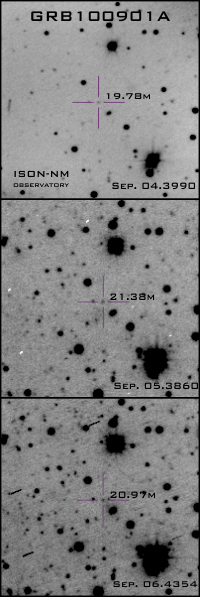
- GCN Circular #11236
D. A. Kann, U. Laux and B. Stecklum (TLS Tautenburg) report:
We obtained further observations at multiple epochs of the afterglow of
GRB 100901A (Immler et al., GCN 11159) with the TLS 1.34m Schmidt
telescope. After another completely overcast night, we obtained data under
good to excellent conditions in the third and fourth nights.
For our first epoch (Kann et al., GCN 11187) we had used 5 USNO B1.0 R2
stars. Now, we compare their magnitudes with those derived from the SDSS
catalog. We find that two of the stars we used, at
RA = 01:49:05.595, Dec. = +22:44:51.96;
RA = 01:48:59.497, Dec. = +22:46:18.56
must be variable, they yield strongly divergent zero points compared to
the SDSS values for the other three stars.
For the other three stars, which yield a stable zero point, we find:
RA = 01:48:49.484, Dec. = +22:47:42.14; USNO R2 = 18.44; SDSS = 18.46
RA = 01:48:53.990, Dec. = +22:48:30.07; USNO R2 = 17.73; SDSS = 17.91
RA = 01:49:06.790, Dec. = +22:47:02.97; USNO R2 = 15.37; SDSS = 15.64
Note that the last star has been used by many observers to calibrate the
afterglow, we find that it is 0.27 mag fainter, this is in agreement with
what was reported by Andreev et al., GCN 11191. Recalibrating all reported
magnitudes based on this calibration with this value strongly reduces the
scatter in the light curve. Note the recently reported magnitudes by
Elenin et al. (GCN 11234) are about 0.4 magnitudes too bright.
Using these three stars, we re-calibrate our earlier data and add
additional observations as follows:
Mid-Time Rc dRc Exptime
1.384629 19.16 0.03 1 x 300
1.388656 19.24 0.04 1 x 300
1.424663 19.28 0.03 1 x 300
1.428691 19.36 0.03 1 x 300
1.432719 19.25 0.04 1 x 300
1.436747 19.18 0.04 1 x 300
3.309522 20.53 0.07 4 x 300
3.549130 20.70 0.04 1 x 600 + 2 x 450 + 4 x 300
4.398521 21.30 0.05 4 x 600
4.424271 21.31 0.26 1 x 120
4.430357 21.37 0.13 1 x 600
4.559408 21.27 0.10 1 x 600
Midtime is in days after the trigger, exposure time in seconds.
We find that all observations after one day can be fit with a single power
law with slope alpha = 1.46. This is steeper than the slope reported by
Pandey & Zheng (GCN 11179), in agreement with the break proposed by Kann
et al. (GCN 11187), though we caution the Delta alpha is shallow (and in
agreement with the theoretical value for a cooling break) and there may
still be calibration issues.
This message may be cited.
- GCN Circular #11246
D. A. Kann, F. Ludwig and B. Stecklum (TLS Tautenburg) report:
We observed the afterglow of the Swift GRB 100901A (Immler et al., GCN
11159) with the TLS 1.34m Schmidt telescope under excellent conditions in
the fifth night. We obtained 3 x 600 sec images in Rc, the afterglow is
faintly visible in each single image and well-detected in the stack.
Calibration against the SDSS (Kann et al., GCN 11236) yields Rc = 21.91
+/- 0.11 at 5.550556 days after the GRB. This is somewhat subluminous
compared to the extrapolation of the earlier decay (Kann et al., GCN
11236) but only further deep observations can confirm if another break has
occured.
Further observations are improbably due to upcoming inclement weather.
This message may be cited.
- GCN Circular #11255
V. Rumyantsev (CrAO), D. Shakhovkoy, A. Pozanenko (IKI) report on behalf of
larger GRB follow-up collaboration:
We observed the afterglow (Immler et al., GCN 11159) of the Swift GRB
100901A (Immler et al., GCN 11159) with AZT-11 telescope of CrAO
observatory on September 3 (UT) 20:24 - 21:18 and 5 (UT) 22:39 - 23:51. The
afterglow photometry is based on the same reference stars of SDSS DR7 used
in our previous reports (GCNs 11191, 11200):
T0+ Filter, Exposure, mag.
(mid, d) (s)
2.3045 R 19x180 20.07 +/- 0.08
4.4045 R 18x180 21.10 +/- 0.20
The photometry is compatible with photometry at the same period (4.39 -
4.55 days) reported by Kann et al (GCN 11236).
- GCN Circular #11256
A.J. van der Horst (NASA/MSFC/ORAU), K. Wiersema (U of Leicester),
A.P. Kamble, R.A.M.J. Wijers, E. Rol (U of Amsterdam) and
C. Kouveliotou (NASA/MSFC) report on behalf of a large collaboration:
"We observed the position of the GRB 100901A afterglow at 4.9 GHz
with the Westerbork Synthesis Radio Telescope at September 6 20.33 UT
to September 7 08.30 UT, i.e. 5.28 - 5.78 days after the burst (GCN 11159).
We confirm our earlier detection (GCN 11221) and measure a brightening
of the radio counterpart at the position of the X-ray and UV/optical
afterglow (GCN 11195), with a flux density of 193 +/- 30 microJy.
We would like to thank the WSRT staff for scheduling and obtaining these
observations."
- GCN Circular #11257
Poonam Chandra (RMC) and Dale A. Frail (NRAO) report on behalf of a larger
collaboration:
"We observed GRB 100901A (Immler et al. GCN 11159) with the Expanded Very Large
Array (EVLA) on September 06.47 UT at a C band wide receiver (receiver
frequency range 4-8 GHz). We detect the radio afterglow of the GRB at the
Swift-XRT position (Osborne et al. GCN 11167) at 4.5 and 7.9 GHz frequencies.
The flux densities at 4.5 and 7.9 GHz bands are 331+/-30 uJy and
440+/-27 uJy, respectively.
The EVLA is still undergoing active commissioning and we caution that
these results should be considered preliminary. The National Radio
Astronomy Observatory is a facility of the National Science Foundation
operated under cooperative agreement by Associated Universities, Inc."
- GCN Circular #11258
D. Kuroda (OAO, NAOJ), H. Hanayama, T. Miyaji, J. Watanabe (IAO, NAOJ),
K. Yanagisawa (OAO, NAOJ), M. Yoshida (Hiroshima), K. Ohta (Kyoto)
and N. Kawai(Tokyo Tech) report on behalf of the MITSuME collaboration:
We observed the field of GRB 100901A (Immler et al., GCN 11159)
with the optical three color (g', Rc and Ic) CCD camera attached
to the Murikabushi 1m telescope of Ishigakijima Astronomical
Observatory.
The observation started on 2010-09-05 19:53:16 UT (~4.3 day after the
burst). We did not detect the previously reported afterglow (Immler
et al., GCN 11159 and many follow-up observations) in all the three
bands.
Three sigma upper limits of the OT are listed below.
We used SDSS catalog for flux calibration.
T0+[day] MID-UT T-EXP[sec] g' Rc Ic
------------------------------------------------------
4.26159 19:50:52 1080.0 >21.6 >21.3 >19.8
------------------------------------------------------
T0+ : Elapsed time after the burst [day]
T-EXP: Total Exposure time [sec]
- GCN Circular #11266
A. Volnova (SAI MSU), A. Pozanenko (IKI), M. Ibrahimov (MAO), B. Hafizov
(MAO), B. Satovski (Astrotel) report on behalf of larger GRB follow-up
collaboration:
We observed the field of the Swift GRB 100901A (Immler et al., GCN 11159)
with AZT-22 telescope of Maidanak observatory starting Sep. 7 (UT)
20:32:06. We clearly detect the afterglow (Immler et al., GCN 11159 and
other follow-up ground based observations) in R-filter. The photometry of a
stacked image is based on the same reference SDSS-DR7 stars used by our
collaboration previously (GCNs 11191, 11200, 11255):
T0+ Filter, Exposure, mag.
(mid, d) (s)
6.2977 R 4*300 22.05+/-0.09
The photometry above confirms suggested break (Kann et al, GCN 11246) in a
light curve of the afterglow.
- GCN Circular #11270
A. Volnova (SAI MASU), A. Pozanenko (IKI), E. Klunko, I. Korobtsev (ISTP) on
behalf of larger GRB follow up collaboration report:
We observed the Swift GRB 100901A (Immler et al., GCN 11159) with
AZT-33IK telescope of Sayan observatory (Mondy) starting Sep. 01 (UT)
13:44:30 and continued observations within 2 nights after burst onset.
Preliminary light curve of Mondy observation in R as well as R, r and
nonfiltered observations inreported on behalf of our follow up
collaboration (Klunko et al, GCN 11162; Andreev et al, GCN 11166; Andreev
et al, GCN 11168; Elenin et al, GCN 11184; Andreev et al, GCN 11191;
Andreev et al, GCN 11200; Andreev et al, GCN 11201; Elenin et al, GCN
11234; Rumyantsev et al, GCN 11255; Volnova et al, GCN 11266) can be found
at
http://grb.rssi.ru/GRB100901A/GRB100901A_lc.png
The photometry calibration was performed against the same SDSS DR7 stars.
There are some distinct features of the light curve. The tail of the flare
reported earlier (Ivanov et al, GCN 11178), the rapid increase brightness
after power law decay until 0.1d since trigger, the deep gap at ~0.13d, and
the bump at ~0.3d corresponding to the bump in XRT light curve (Page et al,
GCN 11171). We also confirm the late break between 5 and 6 days of the
afterglow (Kann et al, GCN 11246; Volnova et al, GCN 11266).
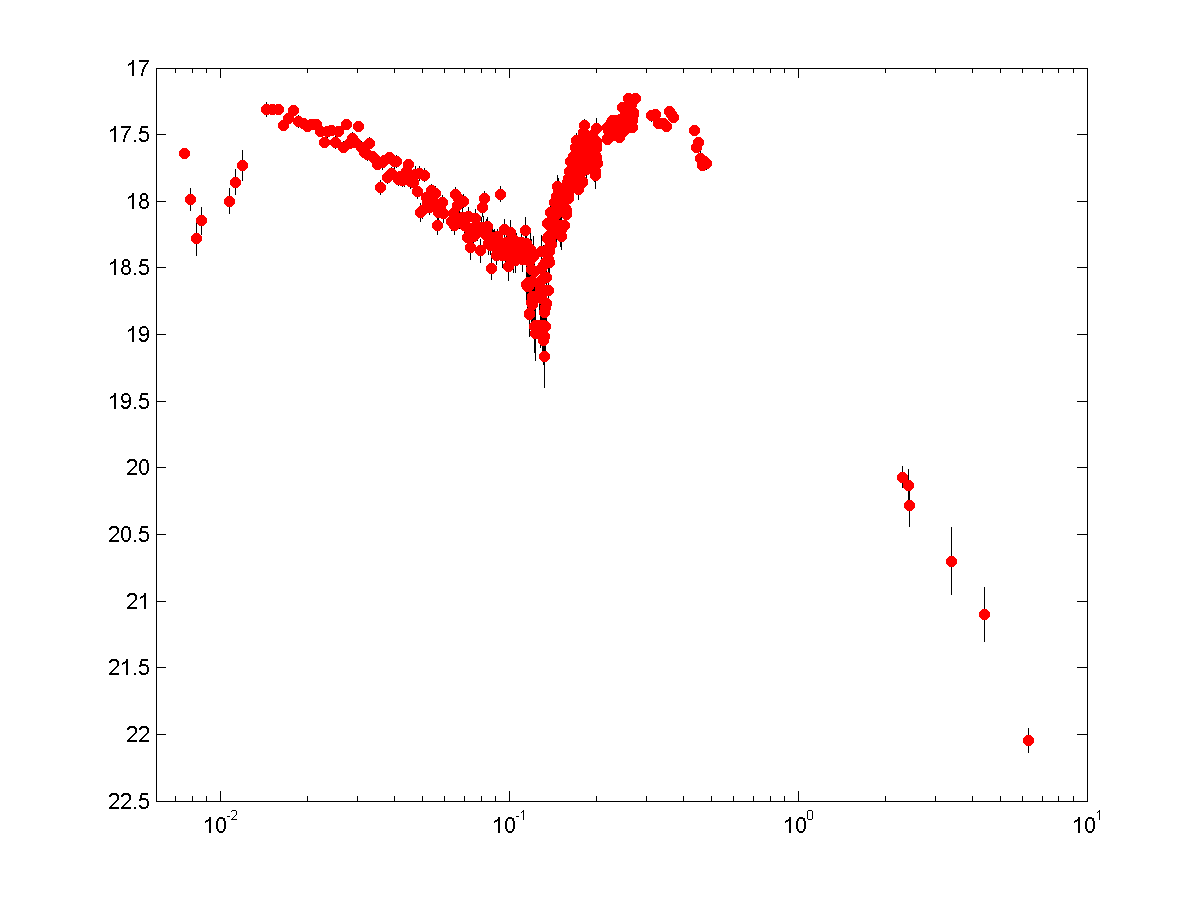
- GCN Circular #11271
A. Pozanenko (IKI) on behalf of larger GRB follow up collaboration report:
In Subject field of GCN 11270 we erroneously reported the GRB name.
It should be "GRB 100901A: optical observations in Mondy and R-light curve"
The light curve of GRB 100906A will be reported later.
We apologize for possible inconvenience.
- GCN Report 304.1
GCN_Report 304.1 has been posted:
http://gcn.gsfc.nasa.gov/reports/report_304_1.pdf
by S. Immler
at CRESST/GSFC/UMD
titled: "Final report on Swift Observations of GRB 100901A"
- 1301.3912 from 18 Jan 13
Olga E. Hartoog et al.: The host-galaxy response to the afterglow of GRB 100901A
For Gamma-Ray Burst 100901A, we have obtained Gemini-North and Very Large Telescope optical afterglow spectra at four epochs: one hour, one
day, three days and one week after the burst, thanks to the afterglow remaining unusually bright at late times. Apart from a wealth of metal
resonance lines, we also detect lines arising from fine-structure levels of the ground state of Fe II, and from metastable levels of Fe II and
Ni II at the host redshift (z = 1.4084). These lines are found to vary significantly in time. The combination of the data and modelling results
shows that we detect the fall of the Ni II 4 F9/2 metastable level population, which to date has not been observed. Assuming that the
population of the excited states is due to the UV-radiation of the afterglow, we estimate an absorber distance of a few hundred pc. This
appears to be a typical value when compared to similar studies. We detect two intervening absorbers (z = 1.3147, 1.3179). Despite the wide
temporal range of the data, we do not see significant variation in the absorption lines of these two intervening systems.
- 1305.1620 from 9 May 13
E. S. Gorbovskoy et al.: The MASTER-II Network of Robotic Optical Telescopes. First Results
The main stages in the creation of the Russian segment of the MASTER network of robotic telescopes is described. This network is designed for
studies of the prompt optical emission of gamma- ray bursts (GRBs; optical emission synchronous with the gamma-ray radiation) and surveys of
the sky aimed at discovering uncataloged objects and photometric studies for various programs. The first results obtained by the network,
during its construction and immediately after its completion in December 2010, are presented. Eighty-nine alert pointings at GRBs (in most
cases, being the first ground telescopes to point at the GRBs) were made from September 2006 through July 2011. The MASTER network holds first
place in the world in terms of the total number of first pointings, and currently more than half of first pointings at GRBs by ground
telescopes are made by the MASTER network. Photometric light curves of GRB 091020, GRB 091127, GRB 100901A, GRB 100906A, GRB 10925A, GRB
110106A, GRB 110422A, and GRB 110530A are presented. It is especially important that prompt emission was ob- served for GRB 100901A and GRB
100906A, and thar GRB 091127, GRB 110422A, and GRB 110106A were observed from the first seconds in two polarizations. Very-wide-field cameras
carried out synchronous observations of the prompt emission of GRB 081102, GRB 081130B, GRB 090305B, GRB 090320B, GRB 090328, and GRB 090424.
Discoveries of Type Ia supernovae are ongoing (among them the brightest supernova in 2009): 2008gy, 2009nr, 2010V, and others. In all,
photometry of 387 supernovae has been carried out, 43 of which were either discovered or first observed with MASTER telescopes; more than half
of these are Type Ia supernovae. Photometric studies of the open clusters NGC 7129 and NGC 7142 have been conducted, leading to the discovery
of 38 variable stars.
![]() Previous IAU Circulars
Previous IAU Circulars 











